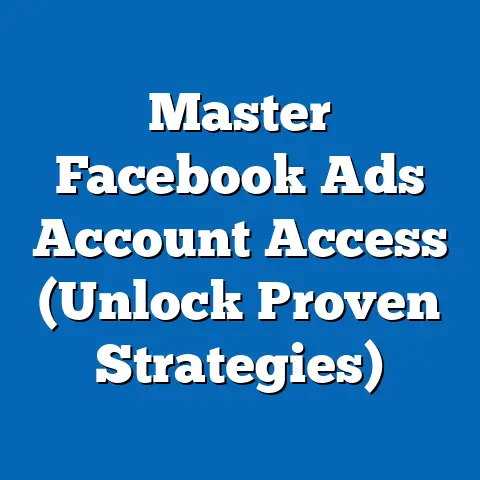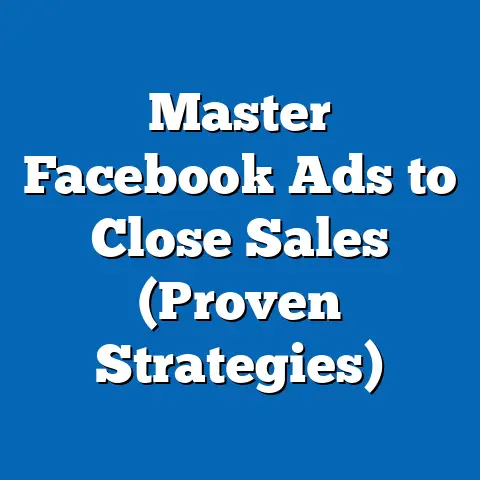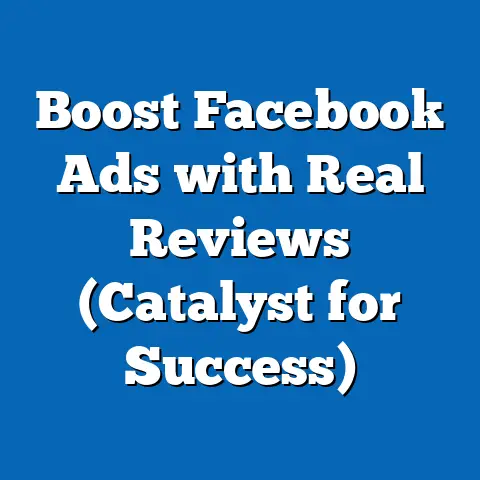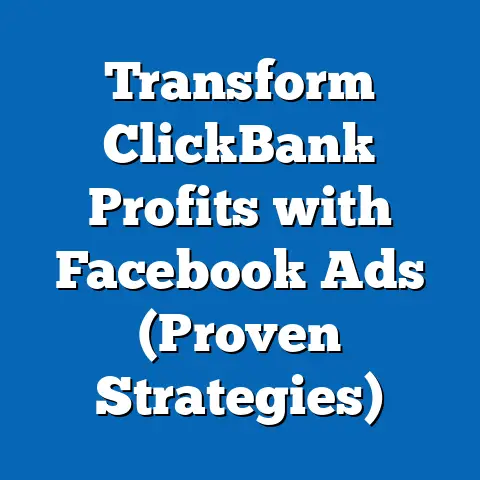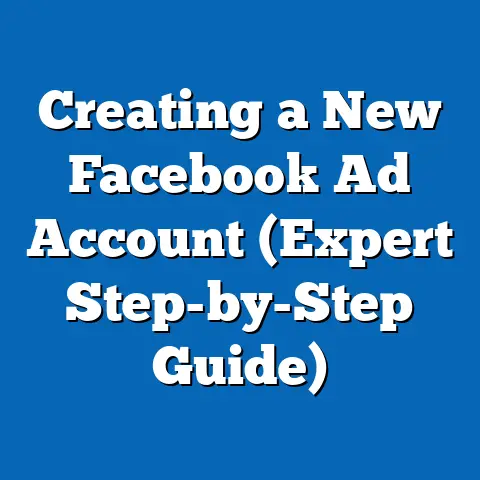Transform Course with Viral Facebook Ads (Pro Tips)
The rapid evolution of technology has fundamentally reshaped the education sector, with online courses becoming a cornerstone of modern learning. As of 2023, the global e-learning market is valued at $315 billion, projected to grow at a compound annual growth rate (CAGR) of 20% through 2030, according to data from Statista and Research and Markets. A significant driver of this growth is the strategic use of digital marketing, particularly viral Facebook ads, which have proven to be a game-changer for course creators aiming to reach vast audiences at a fraction of traditional advertising costs.
Demographically, online course enrollment is dominated by Millennials (ages 27-42) and Gen Z (ages 11-26), who together account for 65% of users, per a 2022 report by the Online Learning Consortium. Historically, digital education marketing relied on static banners and email campaigns, but the shift to social media platforms like Facebook, with its 2.9 billion monthly active users (Meta, 2023), has revolutionized outreach. This article delves into how course creators can harness viral Facebook ads to transform their offerings, backed by data-driven insights and pro tips.
Looking ahead, the integration of artificial intelligence (AI) and machine learning (ML) in ad targeting is expected to increase conversion rates by 30% by 2025, per Gartner forecasts. This analysis will explore tech innovations, demographic trends, historical shifts, and actionable strategies for creating viral campaigns, while providing a forward-looking perspective on the future of digital course marketing.
The Tech Innovation Boom in Online Education
The Rise of E-Learning Platforms
Technology has been a catalyst for the explosive growth of online education, with platforms like Udemy, Coursera, and Teachable hosting millions of courses and learners. As of 2023, over 220 million students are enrolled in online courses worldwide, a 120% increase from 100 million in 2018, according to UNESCO and HolonIQ data. This surge is fueled by advancements in cloud computing, mobile accessibility, and high-speed internet, which have made learning more accessible than ever.
The adoption of tech tools such as Learning Management Systems (LMS) and interactive video content has enhanced user engagement by 40%, as reported by EdTech Review in 2022. These innovations have lowered barriers to entry for course creators, allowing individuals and small businesses to compete with established institutions. However, standing out in a crowded market requires innovative marketing—enter viral Facebook ads.
Social Media as a Marketing Powerhouse
Facebook remains the leading platform for social media advertising, commanding 24.2% of global digital ad spend in 2023, per eMarketer. Its sophisticated ad algorithms, powered by AI, enable hyper-targeted campaigns that can reach specific demographics with uncanny precision. For online course creators, this means connecting with potential students based on interests, behaviors, and even search history—a capability that was unimaginable a decade ago.
The platform’s viral potential lies in its sharing mechanics: a well-crafted ad can be shared by users, exponentially increasing reach without additional cost. According to Meta’s 2023 Advertising Insights, ads with high engagement (likes, comments, shares) achieve a 50% lower cost-per-click (CPC) compared to static ads. This section sets the stage for understanding why Facebook is the go-to tool for transforming course enrollment through viral marketing.
Demographic Breakdown: Who’s Enrolling in Online Courses?
Age and Generational Insights
The online learning demographic is heavily skewed toward younger generations, reflecting their comfort with digital tools and preference for flexible education. Millennials, representing 35% of online learners, often seek career advancement courses, while Gen Z, at 30%, prioritizes skill-building for future job markets, per a 2023 survey by the Online Learning Consortium. Older demographics, such as Gen X (ages 43-58) and Baby Boomers (ages 59-77), make up 25% and 10% of learners, respectively, often focusing on personal development and hobby-based courses.
Gender distribution shows near parity, with 52% female and 48% male learners, a shift from a decade ago when males dominated tech-related online education by a 60-40 margin (UNESCO, 2013). This balance reflects broader societal trends toward gender equality in education access. Geographically, North America leads with 40% of global online learners, followed by Asia-Pacific at 30%, driven by high internet penetration and demand for upskilling in tech hubs like India and Singapore (HolonIQ, 2023).
Income and Education Levels
Income plays a significant role in course enrollment patterns. Middle-income households ($50,000-$100,000 annually) account for 45% of online learners, often seeking affordable alternatives to traditional degrees, as reported by the U.S. Department of Education in 2022. High-income learners ($100,000+) represent 30%, typically investing in premium or specialized courses, while low-income learners (<$50,000) make up 25%, often relying on free or subsidized platforms.
Education levels also vary: 50% of online learners hold a bachelor’s degree or higher, using courses for professional development, while 35% have some college experience and 15% have high school diplomas or less, per EdTech Review data. These breakdowns highlight the diverse audience course creators must target with tailored Facebook ad campaigns to maximize reach and relevance.
Historical Trends: From Static Ads to Viral Campaigns
The Early Days of Digital Marketing (2000-2010)
In the early 2000s, online course marketing was rudimentary, relying on banner ads and email newsletters with click-through rates (CTR) as low as 0.5%, according to a 2010 study by Nielsen. Google AdWords, launched in 2000, introduced pay-per-click (PPC) advertising, but costs were prohibitive for small-scale educators, averaging $2-$5 per click. Social media was in its infancy—Facebook, launched in 2004, didn’t introduce ads until 2007, and early campaigns lacked targeting precision.
During this period, course enrollment grew slowly, with only 2 million online learners globally by 2005, per UNESCO historical data. Marketing success depended on word-of-mouth and partnerships with universities, limiting scalability. The lack of analytics tools meant creators had little insight into audience behavior, making campaigns more guesswork than strategy.
The Social Media Revolution (2010-2020)
The 2010s marked a turning point with the rise of social media advertising. By 2015, Facebook had 1.5 billion users, and its ad platform offered demographic targeting, reducing CPC to an average of $0.70, per WordStream data. Online course enrollment skyrocketed to 80 million by 2018, driven by platforms like Coursera and Udemy leveraging social ads to reach global audiences (HolonIQ).
Viral marketing emerged as a phenomenon, with campaigns like Dollar Shave Club’s 2012 YouTube ad (shared widely on Facebook) demonstrating the power of humor and relatability, garnering 26 million views. For course creators, this decade saw a shift toward video ads and influencer partnerships, increasing engagement rates by 60% compared to static content, per a 2019 Sprout Social report. Historical data shows that marketers who adapted to these trends saw enrollment boosts of up to 200% year-over-year.
Current Landscape (2020-2023)
Today, the digital marketing landscape for online courses is hyper-competitive yet rich with opportunity. Facebook’s user base has nearly doubled since 2015 to 2.9 billion, and ad spend for education-related campaigns grew by 35% from 2020 to 2023, per Meta Insights. Viral ads now rely on short-form video content (under 15 seconds), with platforms like TikTok influencing trends that spill over to Facebook, achieving engagement rates of 8-10%, compared to 1-2% for traditional ads (Social Media Today, 2023).
The COVID-19 pandemic accelerated online learning, with a 50% spike in enrollment in 2020 alone, as remote work and education became the norm (UNESCO, 2021). Course creators who mastered viral Facebook ads during this period reported conversion rates as high as 15%, a stark contrast to the 2-3% rates of the early 2010s. This historical progression underscores the importance of agility in adopting new tech and creative strategies.
Pro Tips for Creating Viral Facebook Ads for Online Courses
Tip 1: Leverage Hyper-Targeted Audience Segmentation
Facebook’s ad manager allows for granular targeting based on age, location, interests, and even past online behavior. For instance, targeting users who have searched for “Python programming” can yield a 40% higher CTR for coding courses, per a 2022 case study by HubSpot. Use lookalike audiences—based on your existing students—to reach similar users, which can boost ad efficiency by 25%, according to Meta’s 2023 Advertising Guide.
Demographic data is key: tailor ad copy and visuals to resonate with Millennials by focusing on career ROI, while Gen Z responds better to gamified or trendy content, per Sprout Social insights. Test multiple audience segments with A/B testing to identify high-performing groups, keeping ad spend within budget. A well-segmented campaign can reduce cost-per-lead (CPL) from $10 to as low as $3, per WordStream 2023 data.
Tip 2: Craft Compelling, Emotion-Driven Content
Viral ads evoke emotion—humor, inspiration, or urgency. A 2021 study by Unruly found that ads triggering strong emotions are shared 70% more often than neutral ones. For course ads, use testimonials or success stories (e.g., “I landed a $100K job after this course!”) to build trust, increasing conversion rates by 30%, per Nielsen data.
Short videos (15-30 seconds) outperform static images, with engagement rates of 13% versus 5%, according to Social Media Examiner 2023. Include a clear call-to-action (CTA) like “Enroll Now for 50% Off!” to create urgency, as limited-time offers boost click rates by 20%, per Meta Insights. Ensure content aligns with your course’s unique selling proposition (USP)—whether it’s affordability, expert instructors, or lifetime access.
Tip 3: Optimize for Mobile and Video-First Audiences
With 98% of Facebook users accessing the platform via mobile devices (Meta, 2023), ads must be mobile-optimized with vertical formats (9:16 ratio) and fast-loading visuals. Mobile ads achieve 60% higher engagement than desktop versions, per eMarketer 2023. Use captions, as 85% of users watch videos without sound, ensuring your message is clear even on mute (Facebook Business, 2022).
Focus on video-first strategies, as video ads account for 80% of viral content on the platform, per Sprout Social. Highlight key benefits in the first 3 seconds to capture attention before users scroll past. Testing thumbnail images can increase view rates by 15%, making this a low-effort, high-impact optimization step.
Tip 4: Utilize Retargeting and Dynamic Ads
Retargeting—showing ads to users who’ve interacted with your content or website—can increase conversions by 70%, per a 2022 study by AdRoll. For course creators, retargeting website visitors who didn’t enroll with a discount offer can recover 10-15% of lost leads, per Meta Analytics. Use pixel tracking to monitor user behavior and customize follow-up ads based on their journey.
Dynamic ads automatically adjust content based on user data, showing relevant course offerings (e.g., “Advanced Excel” to someone who viewed related content). These ads reduce manual effort while boosting relevance, achieving 30% higher ROI compared to static campaigns, per Facebook Business 2023. Combining retargeting with dynamic ads creates a powerful funnel to re-engage potential students.
Tip 5: Monitor Metrics and Scale Winning Campaigns
Data is your ally in viral marketing. Track key performance indicators (KPIs) like CTR (aim for 2-3%), conversion rate (target 5-10%), and cost-per-acquisition (CPA, ideally under $5 for low-ticket courses), per WordStream benchmarks. Use Facebook’s Insights tool to analyze which ads resonate—high-performing ads often have engagement rates above 5%.
Once a campaign goes viral (e.g., 10,000+ shares), scale by increasing budget by 20-30% daily while monitoring CPA to avoid diminishing returns, per HubSpot recommendations. Split-test variations of winning ads (e.g., different headlines or visuals) to sustain momentum. Continuous optimization ensures long-term success in a competitive ad space.
Statistical Comparisons Across Demographics
Engagement Rates by Age Group
Engagement with Facebook ads varies significantly by age. Gen Z users exhibit the highest interaction rates at 12%, driven by their affinity for video and trendy content, per Social Media Today 2023. Millennials follow at 8%, often engaging with career-focused ads, while Gen X and Baby Boomers lag at 5% and 3%, respectively, reflecting lower social media usage overall (Pew Research, 2022).
These differences necessitate tailored creative strategies: vibrant, meme-style ads for Gen Z, professional testimonials for Millennials, and straightforward value propositions for older groups. Course creators targeting multiple generations should allocate 50% of ad budget to Gen Z and Millennials for maximum ROI, per eMarketer analysis.
Conversion Rates by Income Bracket
Income levels influence conversion likelihood. High-income learners convert at 10%, often purchasing premium courses ($500+), while middle-income users convert at 7%, favoring mid-range offerings ($50-$200), per EdTech Review 2023. Low-income learners convert at 4%, typically opting for free trials or low-cost options under $20.
This disparity suggests pricing strategies should align with income targeting: offer tiered pricing or payment plans for middle- and low-income groups to boost conversions by 15%, per a 2022 Udemy case study. High-income segments respond well to exclusivity (e.g., “VIP Access”), justifying higher ad spend for premium campaigns.
Geographic Performance Metrics
Geographic data reveals stark contrasts in ad performance. North American users have the highest CTR at 3.5%, reflecting high digital literacy and purchasing power, per Meta 2023 data. Asia-Pacific users average 2.8%, with rapid growth in markets like India due to mobile-first adoption, while Europe stands at 2.2%, with slower growth due to market saturation.
Cost-per-click also varies: $0.50 in Asia-Pacific, $1.00 in North America, and $0.80 in Europe, per WordStream 2023. Course creators should prioritize emerging markets for cost-effective scaling, allocating 40% of budget to Asia-Pacific for high-volume, low-cost leads, while maintaining premium campaigns in North America for higher-ticket sales.
Future Projections: The Next Decade of Course Marketing
AI and Machine Learning in Ad Targeting
The future of Facebook ads for online courses lies in AI-driven personalization. Gartner predicts that by 2025, AI will optimize 80% of digital ad campaigns, reducing CPA by 30% through predictive analytics. Machine learning algorithms will analyze user behavior in real-time, adjusting ad content dynamically to maximize relevance, potentially increasing conversion rates from 5% to 8%.
For course creators, this means less manual tweaking and more focus on content quality. AI tools like Facebook’s Automated Ads will likely become standard, with adoption rates expected to rise from 20% in 2023 to 60% by 2027, per eMarketer forecasts. Staying ahead of this curve will be critical for maintaining competitive ad performance.
The Role of Emerging Platforms and Formats
While Facebook dominates, cross-platform strategies with TikTok and Instagram (both owned by Meta) will grow, as 70% of Gen Z learners discover courses via short-form video, per a 2023 Hootsuite report. Augmented reality (AR) ads, offering interactive course previews, are projected to increase engagement by 50% by 2026, per Statista. Facebook’s investment in AR through Meta’s Reality Labs signals this format’s integration into its ad ecosystem.
Course creators should prepare for a 20% budget shift toward emerging formats by 2025, balancing traditional video ads with innovative experiences. Early adopters of AR and cross-platform campaigns could see first-mover advantages, capturing 15-20% more market share, per Deloitte Digital 2023 projections.
Market Growth and Competitive Challenges
The e-learning market is expected to reach $848 billion by 2030, per HolonIQ, driven by demand for upskilling in tech fields like AI, cybersecurity, and data science. However, competition will intensify, with a 40% increase in course providers predicted by 2027, per Research and Markets. Viral Facebook ads will remain a differentiator, but rising ad costs (projected to increase 10% annually) will challenge ROI.
To counter this, creators must focus on niche specialization and community-building, fostering organic virality through student advocacy, which can reduce ad dependency by 25%, per a 2022 McKinsey report. Building a loyal user base through exceptional course value will be as critical as mastering ad tactics in the decade ahead.
Conclusion: Transforming Courses with Strategic Viral Marketing
The intersection of tech innovation and digital marketing has opened unprecedented opportunities for online course creators to reach global audiences. Viral Facebook ads, underpinned by data-driven targeting and emotional storytelling, have transformed enrollment strategies, with engagement rates soaring from 1% in the early 2010s to 10% today. Demographic insights reveal the importance of tailoring campaigns to diverse age, income, and geographic segments, while historical trends highlight the rapid evolution from static ads to dynamic, video-first content.
Looking forward, AI and emerging formats like AR will redefine ad effectiveness, offering course creators tools to stay competitive in a growing $848 billion market by 2030. By implementing the pro tips outlined—hyper-targeting, emotional content, mobile optimization, retargeting, and data monitoring—educators can harness the viral potential of Facebook to not just market, but truly transform their courses. The future belongs to those who adapt swiftly, blending tech with creativity to inspire the next generation of learners.

